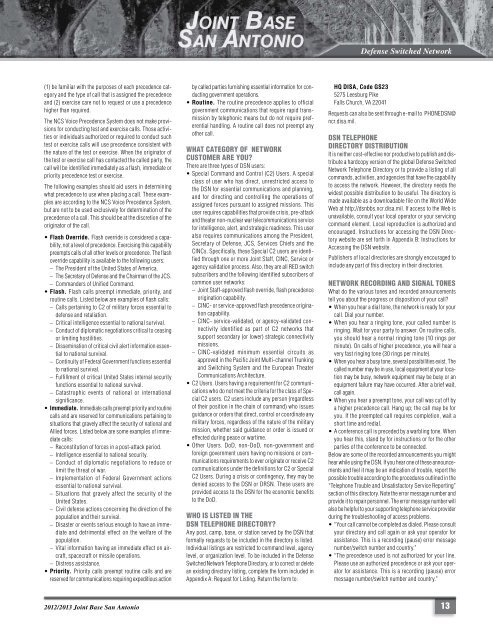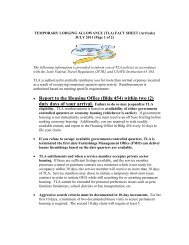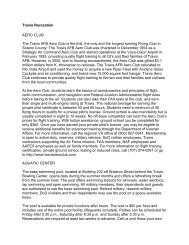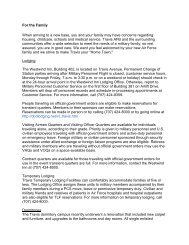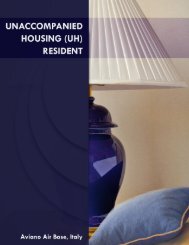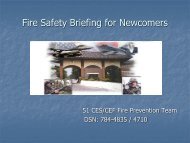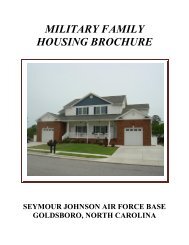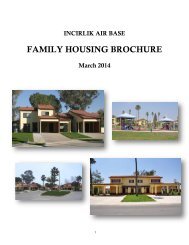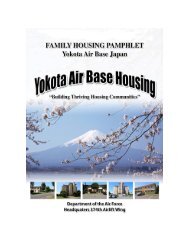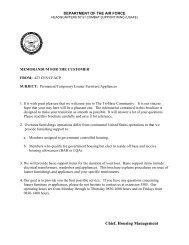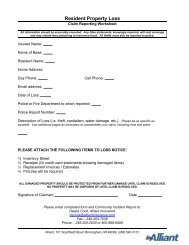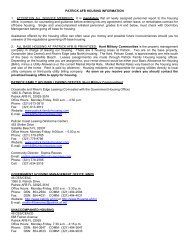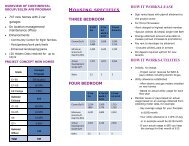San Antonio Military Telephone Directory - Air Force Housing
San Antonio Military Telephone Directory - Air Force Housing
San Antonio Military Telephone Directory - Air Force Housing
You also want an ePaper? Increase the reach of your titles
YUMPU automatically turns print PDFs into web optimized ePapers that Google loves.
Defense Switched Network<br />
(1) be familiar with the purposes of each precedence category<br />
and the type of call that is assigned the precedence<br />
and (2) exercise care not to request or use a precedence<br />
higher than required.<br />
The NCS Voice Precedence System does not make provisions<br />
for conducting test and exercise calls. Those activities<br />
or individuals authorized or required to conduct such<br />
test or exercise calls will use precedence consistent with<br />
the nature of the test or exercise. When the originator of<br />
the test or exercise call has contacted the called party, the<br />
call will be identified immediately as a flash, immediate or<br />
priority precedence test or exercise.<br />
The following examples should aid users in determining<br />
what precedence to use when placing a call. These examples<br />
are according to the NCS Voice Precedence System,<br />
but are not to be used exclusively for determination of the<br />
precedence of a call. This should be at the discretion of the<br />
originator of the call.<br />
• Flash Override. Flash override is considered a capability,<br />
not a level of precedence. Exercising this capability<br />
preempts calls of all other levels or precedence. The flash<br />
override capability is available to the following users:<br />
––<br />
The President of the United States of America.<br />
––<br />
The Secretary of Defense and the Chairman of the JCS.<br />
––<br />
Commanders of Unified Command.<br />
• Flash. Flash calls preempt immediate, priority, and<br />
routine calls. Listed below are examples of flash calls:<br />
––<br />
Calls pertaining to C2 of military forces essential to<br />
defense and retaliation.<br />
––<br />
Critical intelligence essential to national survival.<br />
––<br />
Conduct of diplomatic negotiations critical to ceasing<br />
or limiting hostilities.<br />
––<br />
Dissemination of critical civil alert information essential<br />
to national survival.<br />
––<br />
Continuity of Federal Government functions essential<br />
to national survival.<br />
––<br />
Fulfillment of critical United States internal security<br />
functions essential to national survival.<br />
––<br />
Catastrophic events of national or international<br />
significance.<br />
• Immediate. Immediate calls preempt priority and routine<br />
calls and are reserved for communications pertaining to<br />
situations that gravely affect the security of national and<br />
Allied forces. Listed below are some examples of immediate<br />
calls:<br />
––<br />
Reconstitution of forces in a post-attack period.<br />
––<br />
Intelligence essential to national security.<br />
––<br />
Conduct of diplomatic negotiations to reduce or<br />
limit the threat of war.<br />
––<br />
Implementation of Federal Government actions<br />
essential to national survival.<br />
––<br />
Situations that gravely affect the security of the<br />
United States.<br />
––<br />
Civil defense actions concerning the direction of the<br />
population and their survival.<br />
––<br />
Disaster or events serious enough to have an immediate<br />
and detrimental effect on the welfare of the<br />
population.<br />
––<br />
Vital information having an immediate effect on aircraft,<br />
spacecraft or missile operations.<br />
––<br />
Distress assistance.<br />
• Priority. Priority calls preempt routine calls and are<br />
reserved for communications requiring expeditious action<br />
by called parties furnishing essential information for conducting<br />
government operations.<br />
• Routine. The routine precedence applies to official<br />
government communications that require rapid transmission<br />
by telephonic means but do not require preferential<br />
handling. A routine call does not preempt any<br />
other call.<br />
WHAT CATEgory OF NEtwork<br />
CUStomER ARE YOU<br />
There are three types of DSN users:<br />
• Special Command and Control (C2) Users. A special<br />
class of user who has direct, unrestricted access to<br />
the DSN for essential communications and planning,<br />
and for directing and controlling the operations of<br />
assigned forces pursuant to assigned missions. This<br />
user requires capabilities that provide crisis, pre-attack<br />
and theater non-nuclear war telecommunications service<br />
for intelligence, alert, and strategic readiness. This user<br />
also requires communications among the President,<br />
Secretary of Defense, JCS, Services Chiefs and the<br />
CINCs. Specifically, these Special C2 users are identified<br />
through one or more Joint Staff, CINC, Service or<br />
agency validation process. Also, they are all RED switch<br />
subscribers and the following identified subscribers of<br />
common user networks:<br />
––<br />
Joint Staff-approved flash override, flash precedence<br />
origination capability.<br />
––<br />
CINC- or service-approved flash precedence origination<br />
capability.<br />
––<br />
CINC- service-validated, or agency-validated connectivity<br />
identified as part of C2 networks that<br />
support secondary (or lower) strategic connectivity<br />
missions.<br />
––<br />
CINC-validated minimum essential circuits as<br />
approved in the Pacific Joint Multi-channel Trunking<br />
and Switching System and the European Theater<br />
Communications Architecture.<br />
• C2 Users. Users having a requirement for C2 communications<br />
who do not meet the criteria for the class of Special<br />
C2 users. C2 users include any person (regardless<br />
of their position in the chain of command) who issues<br />
guidance or orders that direct, control or coordinate any<br />
military forces, regardless of the nature of the military<br />
mission, whether said guidance or order is issued or<br />
effected during peace or wartime.<br />
• Other Users. DoD, non-DoD, non-government and<br />
foreign government users having no missions or communications<br />
requirements to ever originate or receive C2<br />
communications under the definitions for C2 or Special<br />
C2 Users. During a crisis or contingency, they may be<br />
denied access to the DSN or DRSN. These users are<br />
provided access to the DSN for the economic benefits<br />
to the DoD.<br />
WHO IS LISTED IN THE<br />
DSN TELEphonE DIREctory<br />
Any post, camp, base, or station served by the DSN that<br />
formally requests to be included in the directory is listed.<br />
Individual listings are restricted to command level, agency<br />
level, or organization level. To be included in the Defense<br />
Switched Network <strong>Telephone</strong> <strong>Directory</strong>, or to correct or delete<br />
an existing directory listing, complete the form included in<br />
Appendix A: Request for Listing. Return the form to:<br />
HQ Disa, Code GS23<br />
5275 Leesburg Pike<br />
Falls Church, VA 22041<br />
Requests can also be sent through e-mail to PHONEDSN@<br />
ncr.disa.mil.<br />
DSN TELEphonE<br />
DIREctory DIStribution<br />
It is neither cost-effective nor productive to publish and distribute<br />
a hardcopy version of the global Defense Switched<br />
Network <strong>Telephone</strong> <strong>Directory</strong> or to provide a listing of all<br />
commands, activities, and agencies that have the capability<br />
to access the network. However, the directory needs the<br />
widest possible distribution to be useful. The directory is<br />
made available as a downloadable file on the World Wide<br />
Web at http://dsnbbs.ncr.disa.mil. If access to the Web is<br />
unavailable, consult your local operator or your servicing<br />
command element. Local reproduction is authorized and<br />
encouraged. Instructions for accessing the DSN <strong>Directory</strong><br />
website are set forth in Appendix B: Instructions for<br />
Accessing the DSN website.<br />
Publishers of local directories are strongly encouraged to<br />
include any part of this directory in their directories.<br />
NEtwork REcording AND SIGNAL TONES<br />
What do the various tones and recorded announcements<br />
tell you about the progress or disposition of your call<br />
• When you hear a dial tone, the network is ready for your<br />
call. Dial your number.<br />
• When you hear a ringing tone, your called number is<br />
ringing. Wait for your party to answer. On routine calls,<br />
you should hear a normal ringing tone (10 rings per<br />
minute). On calls of higher precedence, you will hear a<br />
very fast ringing tone (30 rings per minute).<br />
• When you hear a busy tone, several possibilities exist. The<br />
called number may be in use, local equipment at your location<br />
may be busy, network equipment may be busy or an<br />
equipment failure may have occurred. After a brief wait,<br />
call again.<br />
• When you hear a preempt tone, your call was cut off by<br />
a higher precedence call. Hang up; the call may be for<br />
you. If the preempted call requires completion, wait a<br />
short time and redial.<br />
• A conference call is preceded by a warbling tone. When<br />
you hear this, stand by for instructions or for the other<br />
parties of the conference to be connected.<br />
Below are some of the recorded announcements you might<br />
hear while using the DSN. If you hear one of these announcements<br />
and feel it may be an indication of trouble, report the<br />
possible trouble according to the procedures outlined in the<br />
“<strong>Telephone</strong> Trouble and Unsatisfactory Service Reporting”<br />
section of this directory. Note the error message number and<br />
provide it to repair personnel. The error message number will<br />
also be helpful to your supporting telephone service provider<br />
during the troubleshooting of access problems.<br />
• “Your call cannot be completed as dialed. Please consult<br />
your directory and call again or ask your operator for<br />
assistance. This is a recording (pause) error message<br />
number/switch number and country.”<br />
• “The precedence used is not authorized for your line.<br />
Please use an authorized precedence or ask your operator<br />
for assistance. This is a recording (pause) error<br />
message number/switch number and country.”<br />
2012/2013 Joint Base <strong>San</strong> <strong>Antonio</strong><br />
13


